
The advantageous physical properties and manufacturing characteristics of Osprey Controlled Expansion (CE) alloys are currently being exploited in a variety of electronic applications. The ability to tailor the coefficient of thermal expansion (CTE) values of these alloys to ceramic circuit boards and components operating at high frequencies, combined with their lightness, high thermal conductivity, dimensional stability and manufacturability, have made them attractive for RF/microwave packages and carriers and also for heat sinks. The additional benefit of high stiffness has made the CE alloys with lower CTEs eminently suitable for optical and optoelectronic housings. On the other hand, the higher thermal expansion CE alloys are being increasingly used in carrier plates for laminate PCBs, guide-bars for circuit boards, and jigs and fixtures in semiconductor processing equipment and soldering ovens. This article considers how CE alloys offering these combinations of properties are being adopted for a growing range of applications.

Currently, CE alloys are finding increasing use in the electronics and allied industries for a variety of applications. These lightweight alloys are composed of silicon-aluminum (not AlSiC) and their CTE can be controlled to a chosen value between 7.5 and 20 ppm/°C, simply by adjusting the proportions of these two constituents (see Table 1), making them compatible with many common microelectronic devices and substrates. A 5 ppm/°C grade alloy of 85Si-15Al composition is also under development.
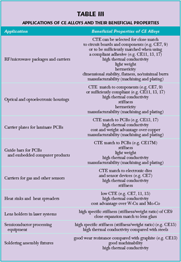
CE alloys are typically between three and six times lighter than established packaging and base plate materials used in RF and microwave products and offer excellent thermal conductivity — a vital requirement for meeting the increased power loading requirements of the latest generation of devices and associated circuitry. They possess high specific stiffness, but are not unduly hard and so are amenable to standard machining operations, such as milling and drilling. Machining operations do not produce burrs on the higher silicon CE alloy parts, in contrast to most other metals, and this obviates the need for operations to remove them. CE alloys are also readily plated, using industry proven methods and being composed of silicon and aluminum, they are environmentally friendly, safe to handle and use, and present no disposal problems. Furthermore, as they do not contain strategic metals, such as cobalt, tungsten and molybdenum, they are far less susceptible to price volatility and supply shortages. Their unusual combination of high thermal conductivity and low thermal capacity, and the fact that heat is distributed relatively evenly, makes for easier soldering of feedthroughs. Because aluminum and silicon are light metals, soldered regions, comprising heavy metals, are readily revealed by X-rays, greatly facilitating nondestructive inspection of joints. Some of the relative benefits of CE alloys over alternatives are summarized in Table 2. The beneficial properties of CE alloys are being exploited in a wide variety of applications, as summarized in Table 3, and will be discussed, giving practical examples of their use.

RF and Microwave Packaging
CE13, 9 and 7 are being widely used for microwave packaging for space and aerospace applications at operating frequencies as high as Ka-band (with an upper limit of 36 GHz), taking advantage of their reasonably close CTE match to circuit boards and components, their high thermal conductivity, low density, hermeticity, dimensional stability and ease of manufacture. While the CTE of CE11 is noticeably higher than that of alumina, which is widely used as substrates for microwave and RF circuits, it is far lower than that of aluminum. More pertinently, it is sufficiently close in its CTE to alumina for moderately compliant conducting adhesives to take up the mismatch stresses without compromising the adhesion or fracturing the alumina substrates. One example is a transmit and receive module, operating in the 3 to 30 GHz range with a housing of CE11, being developed as a replacement for one made of titanium used by Raytheon1 (see Figure 1). Titanium has a poor thermal conductivity and twice the weight of CE11; also, molybdenum-copper inserts have had to be introduced as heat spreaders to extract heat generated by active devices, which adds cost and complexity to their manufacture. By comparison, CE11 possesses a relatively high thermal conductivity, which enables the molybdenum-copper inserts to be dispensed with, at an overall cost reduction. The circuitry is mounted on alumina substrates, which are attached to the base of the housing with a conductive adhesive that is tolerant to the CTE difference.

Raytheon Space and Airborne Systems and Pacific Aerospace and Electronics, the packaging house, are also able to benefit from their ability to use a standard laser welding process for joining the aluminum sleeves of sealed feedthroughs to the packages and satisfy the requisite MIL-STD- 883E specification on hermeticity. They have also verified that the gold-over-nickel plated CE11 packages pass the industry standard MIL-C-5541 salt spray corrosion tests.
CE13 has been chosen by Ericsson Microwave Systems AB as a replacement for Kovar“ for a radar housing (see Figure 2). The CE alloy offers the weight reduction required for this part (as the system into which it is incorporated rotates in use) and heat spreaders are not required. The circuitry is assembled on a CE9 carrier, machined with threaded holes and plated with nickel. This is then bolted down into the CE13 housing, which is also nickel plated, and the circuitry is tuned. Two lids of CE17 are fixed to the top and bottom of the CE13 housing to cover the screw holes, and laser welded in place to provide a hermetic seal. The nickel layer is skimmed off the joint areas to avoid compromising the mechanical integrity of the weld arising from nickel in the weld. The weld has been shown to be fully reproducible and allows for reworking.

Tyco M/A-COM has adopted CE11 for a hermetic microwave amplifier housing in aerospace applications, taking advantage of its lightness and not having to incorporate a heat spreader, thereby resulting in significant space saving (see Figure 3). A steel shim is soldered to this package, and a steel lid is resistance seam-sealed onto it. This solution offers excellent reproducibility, resulting from the high consistency of CE11 and the associated processing, which is responsible for a high yield of this item.
RF and Microwave Carriers
CE alloys are favored as carriers of microelectronic circuitry, in preference to copper-tungsten and copper-molybdenum, on account of their much reduced weight and cost. For example, C-MAC has gained these benefits by substituting carriers of CE7 for 10Cu-90W in Lucent’s 40 Gbit/sec transmit modules. This has simplified manufacturing as, unlike previously, the carriers bear integral plinths for active microwave devices, which have to be located to a precision of 20 mm (see Figure 4). This is achieved through the good machining characteristics of CE alloys, with the added benefit of high edge resolution of features and a high degree of flatness.
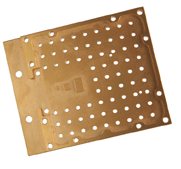
Optical Housings
CE alloys are also suitable for hermetic optical and optoelectronic housings, on account of their close CTE match to components, their almost constant thermal expansion over a normal range of operating temperatures, high thermal conductivity and stiffness, and good manufacturability. For example, Figure 5 shows an optical housing in CE7, which forms part of a high speed MEMS switching device, comprising an array of these modules used in aerospace applications. The housing receives laser inputs and supports a series of mirrors supported by arms screwed into the walls of the housing. It replaces a similar item that was manufactured in stainless steel, which suffered from a number of drawbacks. CE7 provides a lower CTE, a welcome reduction in weight, improved stiffness and rigidity, and stays flat. The housing is plated with gold over nickel and during assembly is manually tuned by careful adjustment of the mirrors, which are then fixed in position by soldering the supporting arms to the housings. The stainless steel housings proved difficult to tune, owing to relative movement of the mirrors when soldering because the steel does not stay flat during the thermal excursion. By comparison, CE7 is dimensionally stable.

Thermal Backing Plates
Another application of note is the use of sheets of CE alloys (CE17 down to CE11) as backing plates to laminate PCBs formulated for high frequency use. These boards possess a polymer matrix, normally a hydrocarbon thermoset or PTFE (Teflon). They are filled with a ceramic to provide a tight control of dielectric constant, low loss and good temperature stability of dielectric properties. Additionally, woven glass reinforcement is added to improve stiffness and reduce the CTE in the x-y plane. CE alloy backing plates are available in sizes up to 20 × 20 inches, and down to 3 mm in thickness. Developments are also in progress to produce larger plates down to 1 mm thickness. Also, plates of up to 6 × 6 inches in area can be sliced to approximately 0.5 mm in thickness. CE17 provides an optimum solution for backing plate applications, as it is lightweight, and offers a good CTE match, high thermal conductivity and high specific stiffness. Its relative stiffness enables the laminate substrate to be made thin while remaining flat and thereby reduce microwave and RF dispersion and radiation losses. An example of a CE17-backed laminate board for a base station application is shown in Figure 6.
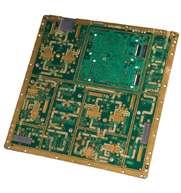
Guide-bars for PCBs
Strips of CE17M are used as guide-bars for PCBs in aircraft and in embedded computer products, as a replacement for the same items in W-50Cu, being cheaper and only one-sixth of the weight. The CE17M grade alloy has small amounts of iron, magnesium and manganese added to the alumina-silicon, to improve hardness and machinability. The guide-bars in this material are stiff and match the CTE of the PCBs, and thereby reduce the CTE mismatch of solder-attached silicon devices, which also results in significant improvements to life fatigue. Recesses are machined on one side of the guide-bars, which are gold plated. Copper-clad projections on the PCBs are fitted into these recesses and soldered in place. The even side of the guide-bars is hard nickel plated for good wear resistance when the boards are slid into racks and then mechanically fastened down. Such guide-bars are illustrated in Figure 7.
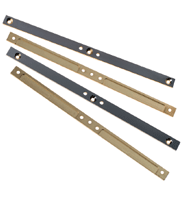
Carriers for Sensors
CE7 is being used in carriers for sensors, as a replacement for Cu-W. The specific benefits of the CE alloys for these applications are an excellent CTE match to sensor devices, high thermal conductivity to provide good heat sinking, stiffness, flatness and superior machinability to close tolerances, including crisp edges. In this application, a peripheral recess in the carrier has to be machined to a high finish, to house an O-ring for a vacuum seal, as shown in Figure 8. This particular sensor is used in a mobile military application, where the weight saving over Cu-W is of major benefit. Other important applications of CE alloys include heat sinks and spreaders for power modules and discrete devices, and also microwave filter components, which take advantage of the beneficial characteristics enumerated previously.
Pick-and-place Equipment
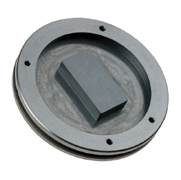
CE13 is being used in pick-and-place assemblies in semiconductor processing equipment and other mechanical systems where low inertia is required. CE alloys are eminently suited for such applications, on account of their unusually high specific stiffness (stiffness/weight ratio) and low thermal expansivity.
Soldering Assembly Fixtures
CE13 alloys are also being used in soldering fixtures in flip chip and ball grid array (BGA) production lines. A fixture of the latter is shown in Figure 9. The controlled thermal expansion of these alloys at elevated temperatures is accurately predictable and helps in precise positioning and soldering of the solder balls in IC assembly lines. Its resistance to chipping and ease of machining to tight tolerances, in an application where high precision of feature definition is required, are beneficial. It also offers the further advantage of superior wear resistance, especially to graphite, which results in an enhanced service life and the combining of a high thermal conductivity with a low heat capacity, ensures that a uniform temperature distribution is achieved rapidly.

Conclusion
CE alloys offer application solutions, which enhance product performance, reliability, increase in the functionality-to-weight ratio and are cost competitive. They lend themselves to manufacture by standard machining and plating procedures. The favorable combination of processing capabilities of these alloys present flexible opportunities for the manufacture of diverse products. They are available in the form of plates and blocks, or machined and plated components, ready for manufacturing into different products.
Acknowledgments
The contributions of the following individuals are gratefully acknowledged: Mikael Johansson (Ericsson Microwave Systems AB); Philip Hancock (M/A-COM Division, Tyco Electronics UK Ltd.); John Swatman (C-MAC Microcircuits Ltd.); Mike Isles (Radstone Technology Ltd.); Balaji Prasad (PTC Pte Ltd., Singapore); and David Grandguillot and Marie-Joelle Poret (Division Métaux & Matériaux, BFI Optilas SA). Pacific Aerospace and Electronics and Raytheon Space and Airborne Systems are also acknowledged for their inputs.
Reference
1. S. Weinshanker, et al., “High Performance, Lightweight, Hermetic AlSi Packages for Military, Aerospace and Space Applications,” 2nd Advanced Technology Workshop on Military, Aerospace, Space and Homeland Security: Packaging Issues and Applications, Baltimore, MD, 29 March 2004.
